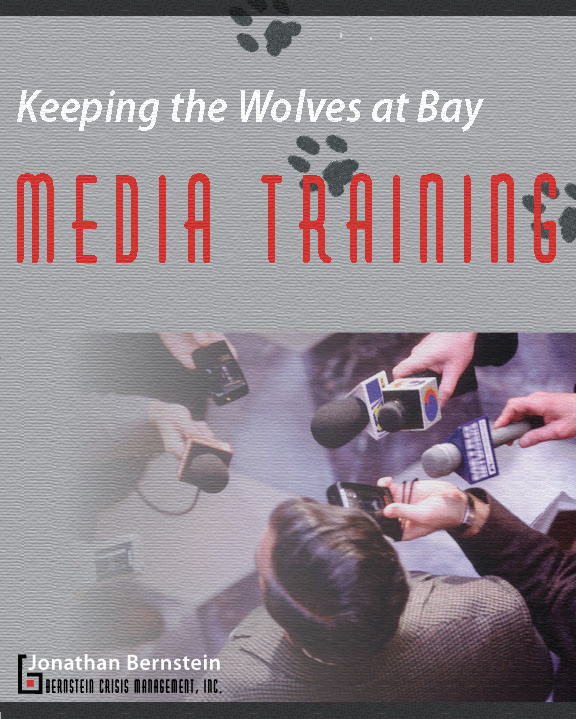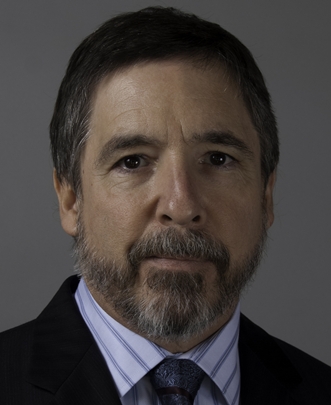|
|

|
CRISIS MANAGER
The Internet Newsletter about Crisis Management
Editor: Jonathan Bernstein
"For Those Who Are Crisis Managers,
Whether They Want to be or Not"
ISSN:1528-3836
� 2010 Jonathan Bernstein
|
Volume XI, Number 15
| October 14, 2010
|
|
JUST A THOUGHT
| Strategy is not a to-do list, it drives a to-do list
Steve Blank |
|
FROM THE EDITOR
When was the last time you read a book report? Probably looking over one of your kids' homework assignments, right? Well, that's the lead story in this issue, courtesy of PIO-trainer and consultant Karen Terrill.
Then, Melissa Mack and Charlie McDonald from Crisis Management International bring us an interesting concept -- The Sincerity Bar -- and how you can clear it.
If you want more than just the education offered by this ezine, please consider browsing the Bernstein Crisis Management blog
I manage with my son Erik and the Crisis Management blog I host over at Carter McNamara's Free Management Library.
As always, if you like what you see, please share it with others by using the "Forward Email" link at the bottom of the ezine and tell them to subscribe! IMPORTANT NOTE: If you just "Forward" using your own email program's "Forward" function and your recipient thinks they're being spammed, they can click on the Opt Out link and opt YOU off the list. So use the "Forward Email" link, please.

My best to all,
Jonathan
|
PUBLIC INFORMATION AND THE UNTHINKABLE
By Karen Terrill |
It has been many years since I wrote a book report. But I recently read The Unthinkable by Amanda Ripley. It spoke so clearly to the crisis communicator in me that I felt the need to tell every
 | | Karen Terrill |
PIO I know about it. So, I posted the following report in the newsletter of the National Information Officers' Association (NIOA) to share with my fellow members. I'm also a member of CESA (California Emergency Services Association). The author of the book, Amanda Ripley, was the keynote speaker at our annual conference this year. She held the audience of emergency responders in rapt attention as she told them how important the proper information is to the public during a crisis. She described how human beings process information and our brains transfer the information into action, or inaction. The take-away message was crystal clear to me. We must consider not only what we say, but what people will hear. And that is affected by their experiences and their state of mind. ktI came across two quotes recently that stopped me cold. One was validating and one was stunning. They both pertain to public information and they are both from a new book; The Unthinkable by Amanda Ripley, a senior writer for Time magazine. This book should be required reading for anyone who is involved in emergency response, especially PIOs. The focus of the book is why some people survive a crisis and some don't. The book is rich with information about how the human brain processes messages during a crisis and then directs the body to respond. But it reads more like a well-written case study, actually, dozens of well-written case studies. It takes you inside the stairwells of the World Trade Center, into the Murrah Building in Oklahoma City, to fires, floods, and airplane crashes. It isn't grisly or voyeuristic. In many ways, it is uplifting and reassuring about the nature of human beings to survive and help others to survive. Back to those quotes: Quote # 1 - "I think (Hurricane) Camille killed more people during (Hurricane) Katrina than it did in 1969". Max Mayfield, Director of the National Hurricane Center.Quote #2 - "Since 9/11 the U.S. government has sent over $23 billion to states and cities in the name of homeland security. Almost none of that money has gone toward intelligently enrolling regular people like you and me in the cause. Why don't we tell people what to do when the nation is on Orange Alert instead of telling them to be afraid? Why does every firefighter in Casper, Wyoming (pop. 50,632) have an eighteen-hundred dollar HAZMAT suit--but we don't each have a statistically derived ranking of the hazards we actually face, and a smart, creative plan for dealing with them?" Amanda Ripley.You can probably guess it was Quote #1 that was stunning to me. Quote #2 validated what many of us have been thinking and saying for years. As PIOs we have always known that more money needs to be spent on public information. People can die due to a lack of information or the belief in wrong information. That leads me to explain Quote #1: The majority of people who stayed in their homes during Katrina and drowned in their attics had one thing in common, they were old. They had been middle-aged when Hurricane Camille went through New Orleans in 1969. Like Katrina, Camille was a Category 5 storm, and these people had lived through it. Many of them told their families that they didn't want to evacuate. They could live through Katrina just like they lived through Camille. But according to The Unthinkable, since Camille, "rapid development had destroyed much of the wetlands that had provided a natural barrier against storm surge". The reader is left to wonder how many lives might have been saved if those people had that piece of information, and of course, if they believed it. I imagined a team of PIOs creating an aggressive information campaign to drive home that single message to these people. Experienced PIOs know the importance of a simple, powerful message...a message that is crafted specifically for a particular group with deliberate attention to their state of mind during a crisis. I wasn't there so I don't know if there was an effort to do this. But the after-action report seems to indicate that this single issue was a cause of multiple fatalities. The Unthinkable tells the reader what PIOs already know... we must consider how people think during a crisis, and treat them accordingly. We are often told that we should not release this or that information because we don't want people to panic. But, as Ms. Ripley points out, people hardly ever panic, in fact, the first response to fright is usually freezing up, or what she calls the "denial phase". We have a "normalcy bias". Meaning we expect everything to be the way it always is, so that when we hear an alarm or someone yells fire, or the ground begins to shake, we don't run screaming. We stop and consider, and mill around and talk to others, and delay our actions, sometimes for extensive periods of time. This book is filled with case studies such as both World Trade Center bombings and Hurricane Katrina in which people died due to lack of information, or faith in wrong information. As PIOs, we are not just practitioners. I believe we should also be advisers. Please consider reading this book, and passing it on to your emergency response coordinators. I think your communities will be safer for it. Karen Terrill has been a crisis communicator for most of her adult life. She was the Lead Public Information Officer for CAL FIRE where she dealt with fires, floods, earthquakes and other major emergencies for more than 20 years. Prior to that she was a broadcast journalist. Today she is the president and lead trainer of Media Survival Group, contracting with the U.S. Dept. of Homeland Security for PIO Team Training. You may reach her at: [email protected]
|
CLEARING THE SINCERITY BAR
By Melissa Mack and Charlie McDonald | The scene is all too familiar - a CEO or top company spokesperson at a podium with microphones splayed in front, offering a scripted statement of apology. It's become somewhat routine, and yet it's a critical step in recovery. But just how much weight does that statement carry? Imagine a high jumper, flinging her body over the bar. If she clears the bar, she lands safely on the foam mat. If she doesn't clear it, she is disqualified. How high is the sincerity bar in crisis communications?
We've seen what happens when a CEO waits too long to make the statement - the company is seen as dismissive, irresponsible, and insensitive. The public is enraged, and the reputation and financial strength of the company are damaged. In this example, the CEO showed up to the high jump competition six days too late and couldn't compete.
We've seen what happens when a CEO makes the apology statement and is not sincere - he comes across as arrogant, the public is enraged, and the traditional and social media worlds devour him. The CEO in this competition did not clear the bar and landed in Russia.
The most interesting example, however, comes from a spokesperson (or two spokespeople in unity) making the statement sincerely and having a positive effect. In 1990, the American Trader oil spill put British Petroleum (yes, really) in the spotlight. Instead of waiting six days to make a statement or making an insincere statement, BP seized the moment, claimed responsibility, demonstrated sincerity, and deftly handled the situation. Richard Levick describes BP's handling of the American Trader spill as a shining example of effective crisis communications. It's hard to disagree with him; searching for information on the BP oil spill of 1990 is basically futile. Even Wikipedia has no entry on the spill; performing a Google search yields few relevant results, indicating that BP handled the spill so effectively that it is basically forgotten two decades letter. It's almost unbelievable: an oil spill strikes the shores of Orange County, CA less than a year after the Exxon Valdez spill and is forgotten? Levick is right - BP's handling of the American Trader spill is a shining moment in effective crisis communications.
So what do the three examples within the oil industry teach us? How high is the sincerity bar that a company CEO or spokesperson must clear in order to restore public trust in a company? If you were that spokesperson, what elements would be included in your statement?
As the leader of the CMI crisis consulting practice and with more than 22 years in the crisis management profession, Charlie McDonald brings many diverse capabilities to CMI clients. For the last 10 years, Charlie has worked with CMI's corporate clients to develop or improve crisis management plans, conduct crisis exercises, and provide strategic direction during actual crises for all types of companies, including chemical, energy, food, financial, pharmaceutical, high-tech, manufacturing, retail and non-profits. |
BUSINESS ANNOUNCEMENTS
(aka blatant self-promotion)
The Art of Celeste Mendelsohn 
This has NOTHING to do with crisis management, but I have to brag on the launch of the new website launched to feature the art of Celeste Mendelsohn -- my wife, partner and Creative Director. This image is Yin-Yang, painted on a wood round. Her work also includes plates, masks, yoga asanas, computer art and even needlework.
Keeping the Wolves at Bay: Media Training
What has 80+ pages of hard-hitting, entertaining and easy-to-read guidance on how to deal with both traditional and online media during times of crisis? The answer is
Keeping the Wolves at Bay - Media Training. The, four-color, perfect-bound, 8x10 manual is currently available both in hardcopy ($25) and PDF form ($10). Volume discounts are available; write to Jonathan Bernstein for that information.
Here's a couple of teaser reviews for you: Jonathan Bernstein's Keeping the Wolves at Bay is an eminently practical guidance for anyone - business leader, celebrity, politician - who must willingly or unwillingly face the glare of media attention. It appears
at a moment in time when the social media and other digital communications have upped the ante exponentially.
Bernstein's practicum on media relations takes on renewed urgency as news, gossip, and opinion now drive
public perception virally and at the speed of light.
Richard Levick, Esq.
President & CEO
Levick Strategic Communications, LLC
Even if you think you'll never, ever be interviewed by the media, buy this book and read it cover to cover. It isn't a substitute for media training. But it will give you the tools and confidence to go head to head -- and possibly even defang -- rabid reporters, blood-thirsty bloggers and social networking buffoons who are out to besmirch your good name. Joan Stewart, The Publicity Hound
The book and other products can be found at the Crisis Manager Bookstore
Want To Blog And Tweet About
Your Organization But Don't Have Time?
Missing out on all the promotional and SEO advantages of doing so? Hire someone to be your voice...like Erik Bernstein, aka "Son of Crisis Manager."
More info:[email protected].
|
GUEST AUTHORS
GUEST AUTHORS are very welcome
to submit material for "Crisis Manager." There is no fee paid, but most
guest authors have reported receiving business inquiries as a result of
appearing in this publication. Case histories, experience-based
lessons, commentary on current news events and editorial opinion are
all eligible for consideration. Submission is not a guarantee of
acceptance.
|
ABOUT THE EDITOR & PUBLISHER
Jonat han Bernstein is president of Bernstein Crisis Management, Inc., a national crisis management public relations agency providing 24/7
access to crisis response professionals. The agency engages in the full
spectrum of crisis management services: crisis prevention, response,
planning & training. He has been in the public relations field
since 1982, following five-year stints in both military intelligence
and investigative reporting. Write to [email protected]. han Bernstein is president of Bernstein Crisis Management, Inc., a national crisis management public relations agency providing 24/7
access to crisis response professionals. The agency engages in the full
spectrum of crisis management services: crisis prevention, response,
planning & training. He has been in the public relations field
since 1982, following five-year stints in both military intelligence
and investigative reporting. Write to [email protected].
|
|
LEGAL DISCLAIMERAll information contained herein is obtained by Jonathan Bernstein from sources believed by Jonathan Bernstein to be accurate and reliable. Because of the possibility of human and mechanical error as well as other factors, neither Jonathan Bernstein nor Bernstein Crisis Management is responsible for any errors or omissions. All information is provided "as is" without warranty of any kind. Bernstein Crisis Management and Jonathan Bernstein make no representations and disclaim all express, implied, and statutory warranties of any kind to the user and/or any third party including, without limitation, warranties as to accuracy, timeliness, completeness, merchantability, or fitness for any particular purpose. Unless due to willful tortuous misconduct or gross negligence, Jonathan Bernstein and Bernstein Crisis Management shall have no liability in tort, contract, or otherwise (and as permitted by law, product liability), to the user and/or any third party. Under no circumstance shall Bernstein Crisis Management or Jonathan Bernstein be liable to the user and/or any third party for any lost profits or lost opportunity, indirect, special, consequential, incidental, or punitive damages whatsoever, even if Bernstein Crisis Management or Jonathan Bernstein has been advised of the possibility of such damages. A service of this newsletter is to provide news summaries and/or snippets to readers. In such instances articles and/or snippets will be reprinted as they are received from the originating party or as they are displayed on the originating website or in the original article. As we do not write the news, we merely point readers to it, under no circumstance shall Bernstein Crisis Management or Jonathan Bernstein be liable to the user and/or any third party for any lost profits or lost opportunity, indirect, special, consequential, incidental, or punitive damages whatsoever due to the distribution of said news articles or snippets that lead readers to a full article on a news service's website, even if Bernstein Crisis Management or Jonathan Bernstein has been advised of the possibility of such damages. Authors of the original news story and their publications shall be exclusively held liable. Any corrections to news stories are not mandatory and shall be printed at the discretion of the list moderator after evaluation on a case-by-case basis.
|
|
|
|
|
|
|
|